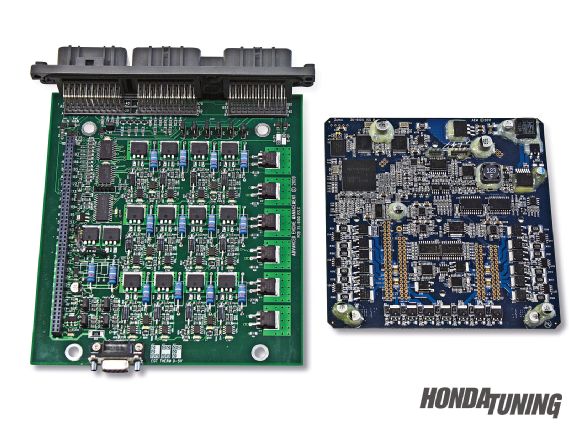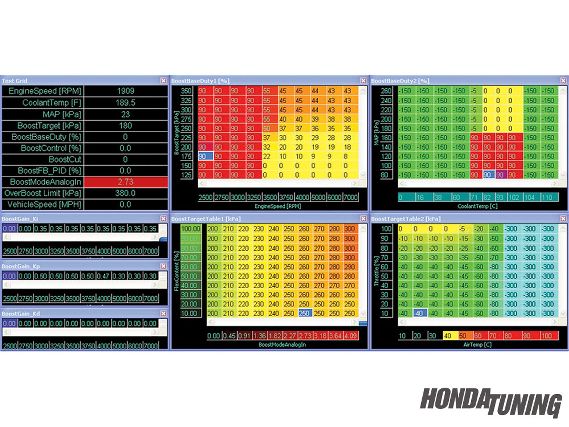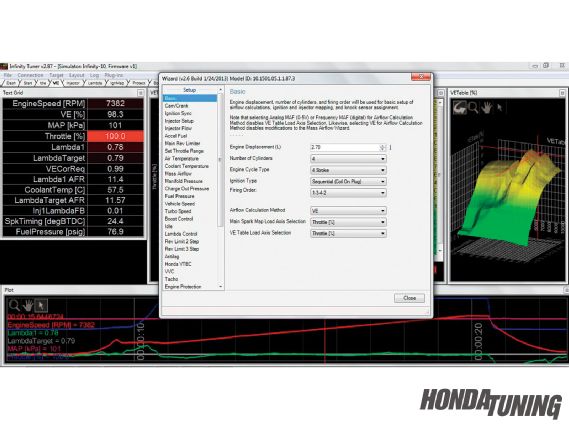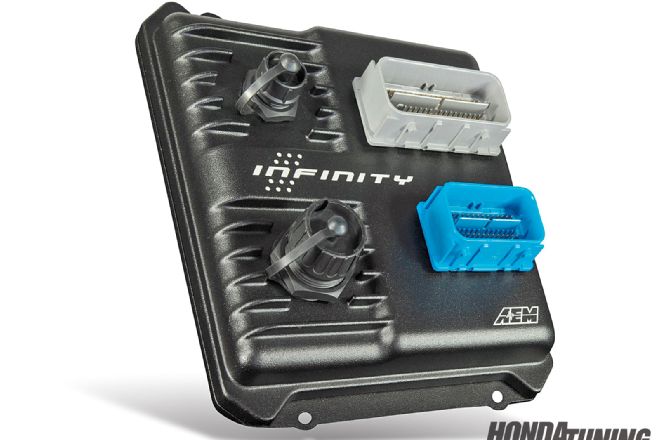Over 10 years ago, AEM Electronics made a major leap forward in the import performance market with its Series 1 EMS system. The idea of an affordable, true plug-and-play system up to that point was unheard of. About seven years later, as technology and signs of competition began to surface, the AEM team unleashed their next generation of engine management with the Series 2 unit that became a smash hit among our industry in virtually every type of motorsport and engine configuration you can possibly imagine. So how do you top a decade of pushing the performance ECU envelope? Easy--just develop a state-of-the-art, revolutionary engine management system offering the ultimate in versatility with a modular design that allows system growth as your car's needs continue to develop. Oh, and keep it reasonably priced, fully enabled (no additional charges to unlock anything), compact, and tuner-friendly with an efficient interface. OK, so maybe it's not all that easy.
From The Outside Looking In
Dimensionally, Infinity is quite a bit smaller than AEM's previous ECU boxes. The automotive-rated motherboard with surface-mount technology keeps the unit and protective case streamlined with a low profile and an overall compact size. Serving as the most vital part of a build, the Infinity was designed with a sealed, weatherproof connection that allows it to be mounted virtually anywhere on or in the car. The small exterior is a bit deceiving as its internals boast some serious mind control via powerful dual processors. The foundation of the Infinity system relies on a primary automotive MCU with a 200 MHz, 32-bit processor with an MIPS rate well into the hundreds. To clear that up and give you an idea of how powerful Infinity really is, here's something to wrap your head around. MIPS, or millions of instructions per second, is a unit of computing speed. On average, most aftermarket EMSs are designed with no more than 50 MIPS in the power-processing department. Infinity is leaps and bounds above that, boasting 400 MIPS! To back that up, a secondary 20 MHz MCU is on deck for onboard power management and future growth. The choice between the Infinity 8, 10, or 12 systems is based on the number of injectors and ignition coil drivers required.
 |
| Software
When the idea of the Infinity system made its way to the table at AEM, user interface was at the top of the crucial elements list. Optimized for speed and accuracy using high-resolution 3-D graphics and numerous control types with customizable layouts, the ECU Setup Wizard makes a tuner's life much easier with its smart, straightforward interface. With the menu on the screen, a tuner need only fill in the blanks for number of cylinders, injectors, displacement, etc.
ECUs of the past required a developer to contribute quite a bit of code. This system is different in that base models are airflow based and feature various modes for proper calculations. Gone are the days of long-winded correction tables, now replaced by calculating an engine's requirements in real time using an advanced engine control model.
Fuel
Flex fuel was another area that AEM felt was essential to the Infinity system. The core control model is designed for just that, and makes automatic adjustments for variances, like ethanol content, and quickly applies them to the fuel flow, ignition timing, and boost target. Also in regard to the fuel department, the system is able to safely run two different types of fuel simultaneously via staged fuel injection.
 |
| B. Second base duty table allows trimming of base duty for more accurate control of boost under varying barometric and exhaust backpressure conditions.
C. Primary boost target table shows how you might target boost to take advantage of traction in lower gears, while targeting higher boost levels with greater ethanol content as traction allows. D. Secondary target table has been set up as a fail-safe protection table that will cut boost in low fuel pressure or high air temperature situations.
Boost Control
Flexible targeting strategies give users plenty of flexibility with up to four settings at the same time. Boost options like gear position, boost by gear, and even settings based on ethanol content can all be customized. Simply put, you have the ability to tailor boost to your needs, which is important when dealing with high-horsepower engines that don't like to hook up. Start off light, then, at your discretion, ramp up to a higher boost setting in third or fourth gear when full traction is realized.
Tip Of The Iceberg
The Infinity's capabilities list runs much longer than these pages, but some other areas of interest tackled by the system include drive-by-wire control and rev limiting, launch limiter, auto calibration, 4GB (up to 64GB based on selected USB drive) of datalogging space, and a host of other goodies. While the average street car owner with a few bolt-ons probably won't be rushing to order, serious builds with competition in mind will undoubtedly be forced to take the plunge on an ECU investment needed to further their cause. Thanks to AEM, they have more than just ultra-high-dollar options, they have something far more affordable that offers everything they could possibly need.
 |
| Real-World R&D
Carey Bales knows a thing or two about competitive drag racing. His Real Street S2000 is capable of clicking off 7.92 blasts while leaving the line in a two-wheel fury, and is armed with an AEM Infinity system. His experience so far, "From a hardware standpoint, the transition to the Infinity system was seamless. All we did was plug in the information on the setup menu and it idled like stock right away. This is the same system guys are using on Vipers, Supras, etc., and with the S2000 info we put in, it fired up on the first hit. There was slight sensor modification for the F series, but it was super-simple stuff based around a cam sensor sync. I'll tell you how safe it is: We went to the NHRA Gator Nationals with Infinity installed and ran into a problem with our fuel pressure fluctuating and actually dropping 20 psi at high rpm! The Infinity fail-safe caught that due to the info we entered, but rather than just shutting down, Infinity rescaled the fuel map, saved the engine, and we kept going. Sure, there are systems out there that will shut the car down, which is great, but remapping the fuel and injector pulse so that if you're in the middle of a run, you won't necessarily lose--that's something else altogether."
 |
| After shocking the world with an All Motor record-setting 9.81 using AEM EMS Series 2, Speedfactory headed to AEM headquarters to make the switch to Infinity. The team's 2.7L naturally aspirated monster was fitted with a custom harness and an Infinity 8 system. AEM ran Speedfactory's James Kempf through the setup process and set initial parameters, and in no time at all, the car was fired up. Power numbers are on par with the previous ECU, the major difference being that as Speedfactory hits the track in various cities, they'll be making changes and datalogging each and every run. With the Infinity's map-switching feature, they can preload maps and make changes with a position switch.
James Kempf states, "The Infinity system has been great. I really like the GUI and the ability to review datalogs within the calibration and have map tracing showing you exactly what areas of the calibration it was using. This greatly speeds up the tuning process and is a feature that is sorely lacking in many other stand-alone systems.
 |
| "The VE-based tuning strategy is also really neat--for instance, we were able to test power differences from running different base fuel pressures by simply adjusting the FPR and doing another dyno pull; no retuning is needed as it monitors and uses the fuel pressure readings to calculate the needed injector pulse-width to achieve the targeted lambda values. It's constantly making fueling calculations based on the VE table and sensor inputs rather than just running a value in a table and then making closed-loop AFR corrections afterward like many other systems.
"On top of the ECU's abilities, the tech support from AEM is also top-notch. I really look forward to using more of its advanced features in the future."
Fast Facts
AEM Electronics Infinity
Applications:
'92-'00 B, D, H series
'01-'05 K series
'99-'04 J series
F20C/F22C (requires slight cam sensor modification)
Availability:
Right now

